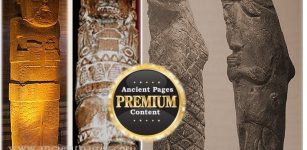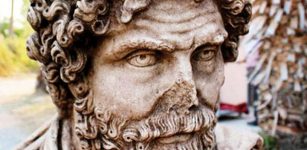Hades – ‘The Unseen’ God Of The Dead, Fertility, Wealth And Earth’s Minerals
A. Sutherland - AncientPages.com - In Greek mythology, Hades was the god of the dead; his counterpart in Roman mythology is Pluto (from Ploutōn – wealthy).
According to a passage in the Iliad (Book XV) by Homer, Hades and his two brothers, Poseidon and Zeus, the god of heaven and the father of the gods of Mount Olympus, who drew lots for realms to rule.
 Left: Bust of Hades ( Palazzo Altemps, Rome); Right: Abduction of Persephone, François Girardon, 1694, Palace of Versailles (Wikipedia)
Left: Bust of Hades ( Palazzo Altemps, Rome); Right: Abduction of Persephone, François Girardon, 1694, Palace of Versailles (Wikipedia)
When the world was divided into three parts, Zeus took the sky, Poseidon gained control of the seas and all the waters on earth, and the underworld became Hades' share.
Hades ruled the world below, and his additional role as God of Wealth or “the rich one” was to make sure that the earth could generate wealth in the form of rich vegetation.
The Origin Of Hades' Name Is Uncertain
In his older form, Hades’ name was Aides (or Aidoneus) and it has been suggested all these names take its origin from ‘awides’ (‘unseen’).
His name is connected with the magic helmet that could make him invisible, even to the immortal eyes.
He received the helmet from the Cyclops, the first generation of giants who were prisoners of Tartarus, also famous for their extraordinary masonry, and blacksmithing.
who helped him in the fight. After the end of the war, when the three brothers Zeus, Hades and Poseidon, divided the power between themselves, Hades fell to the dark realm of the underworld.
Hades Was An Olympian God
Hades belonged to the group of Olympic gods. He was the son of Cronus and Rhea. He had a seat on Mount Olympus but most of his time he used to spend in his Kingdom of the Dead.
Hades and Persephone. Clay plaque, Locri, ca. 480-450 BCE. Museo Archeologico Nazionale, Reggio Calabria. Image via Purdue University
The brothers and sisters of Hades were Zeus, Poseidon, Hestia, Demeter and Hera. Like his all brothers and sisters, (except for Zeus and depending on the version, sometimes also Poseidon), Hades was swallowed and then returned by his father Kronos.
Hades Was In Love With Persephone
Hades fell in love at the very first sight of her. He knew he wanted to marry no one else, so he went to his brother Zeus and said:
“Brother, I am in love with your daughter, Persephone. Let me have your consent to marry her. I will make her the queen of my kingdom in the Underworld….”
Zeus believed that Hades - a fair and powerful god - would be a good husband for Persephone. However, Zeus also knew that Demeter would never allow her daughter to marry Hades and dwell far away in the Underworld.
Demeter and her daughter would be separated forever. Moreover, how could Persephone be happy with Hades in the gloomy realm of the dead, without vegetation?
Persephone did not go to Hades willingly but was abducted by him and made his queen. Her father, Zeus, had previously given Persephone to Hades, to be his wife but her mother Demeter did not agree.
Hades (right-hand side) and Persephone (left-hand side). Detail from an Attic red-figure amphora, ca. 470 BC. From Italy. Image credit: Jastrow/Wikipedia
She cast a curse on the land and there was a great famine. The gods came to request she lift it, but Demeter declared that the earth would remain barren until she saw her daughter again.
Zeus had to propose a compromise, to which all parties agreed. Persephone would spend one-third of the year with her husband in the Underworld. During this time the plants wither on earth and two-thirds of the year with her mother, the earth-goddess, Demeter.
Hades' Appearance And Attributes
Hades was the owner of the invisibility helmet; the narcissus and the cypress were sacred to him. He had his golden chariot, and in his kingdom, he sat on the throne, with his wife, Persephone. Hades is depicted with a gentle face, a horn of abundance in one, and agricultural tools on the other hand. This god rarely appeared on Earth, but if he did, he usually wanted to remain invisible. He did not rebel against his brother Zeus and was considered a good husband and brother.
Characteristics Of Hades
Hades is an iconic and perplexing figure in Greek mythology. Because of his connection to the planet Earth, his connection to Demeter and Persephone, two goddesses that controlled the fertility of the land and the abundance of the harvest.
Hades did not let anyone out of his kingdom if he once entered it. An exception was made for Orpheus, a legendary musician, poet, and prophet in ancient Greek religion, who asked for the return of his beloved Eurydice, alive.
Hades agreed, charmed by his music, but one condition: he should walk in front of her and not look back until they both had reached the upper world. He set off with Eurydice following, and, in his anxiety, as soon as he reached the upper world, he turned to look at her, forgetting that both had to reach the upper world, and she vanished for the second time, but this time forever.
Cult Of Hades
Hades' kingdom of the dead of the same name and many religious ceremonies were dedicated to this feared and highly respected god.
Unlike his sisters and brothers, Hades was not frequently depicted or worshipped and he had only a few individual followers most probably because his mortal name was directly associated with death and his gloomy underground realm.
Many ancient Greeks feared and avoided Hades’ name, which was also the name of his terrifying underground Kingdom of the Dead.
Believed to give the earth abundance in the form of crops, he was honored by farmers under the name of Plouton (Pluto), as the bringer of riches that the land generates. Since precious minerals also originate from under the earth, Hades was considered to have control of them as well, and therefore, his name Plouton was suitable for him.
Written by – A. Sutherland - AncientPages.com Senior Staff Writer
Copyright © AncientPages.com All rights reserved. This material may not be published, broadcast, rewritten or redistributed in whole or part without the express written permission of AncientPages.com
More From Ancient Pages
-
 In Ancient Mesopotamia, Sex Among The Gods Shook Heaven And Earth
Featured Stories | Oct 8, 2022
In Ancient Mesopotamia, Sex Among The Gods Shook Heaven And Earth
Featured Stories | Oct 8, 2022 -
 6,000 Years Ago, Europe’s Oldest Cities Relied On Fertilizer And Plant Protein, Isotope – Analysis Shows
Archaeology | Dec 19, 2023
6,000 Years Ago, Europe’s Oldest Cities Relied On Fertilizer And Plant Protein, Isotope – Analysis Shows
Archaeology | Dec 19, 2023 -
 ‘Arcade’ Of Ancient Mancala Game Boards Carved On Rocks Found In Lewa Wildlife Conservancy, Kenya
Archaeology | Feb 2, 2024
‘Arcade’ Of Ancient Mancala Game Boards Carved On Rocks Found In Lewa Wildlife Conservancy, Kenya
Archaeology | Feb 2, 2024 -
 On This Day In History: John Dee, English Mathematician, Occultist, Astrologer, Astronomer Was Born – On July 13, 1527
News | Jul 13, 2016
On This Day In History: John Dee, English Mathematician, Occultist, Astrologer, Astronomer Was Born – On July 13, 1527
News | Jul 13, 2016 -
 Stone Box With Ancient Shell Llama Offering Found In Lake Titicaca
Archaeology | Aug 4, 2020
Stone Box With Ancient Shell Llama Offering Found In Lake Titicaca
Archaeology | Aug 4, 2020 -
 Mysterious Water Indians: Brotherhood Of Semi-Divine Beings Described As Half Men And Half Fish
Ancient Mysteries | Jul 8, 2014
Mysterious Water Indians: Brotherhood Of Semi-Divine Beings Described As Half Men And Half Fish
Ancient Mysteries | Jul 8, 2014 -
 New Interpretation Of The Domesday Book Of William I The Conqueror
News | Jan 16, 2021
New Interpretation Of The Domesday Book Of William I The Conqueror
News | Jan 16, 2021 -
 1,700-Year-Old Roman Bust Excavated In Ancient City Of Soli Pompeiopolis In Turkey
Archaeology | Jul 19, 2018
1,700-Year-Old Roman Bust Excavated In Ancient City Of Soli Pompeiopolis In Turkey
Archaeology | Jul 19, 2018 -
 Ancient Burial Of Woman Equipped With A Unique Gold Pectoral Ornament Discovered In Siberian ‘Valley Of The Kings’
Archaeology | Feb 15, 2022
Ancient Burial Of Woman Equipped With A Unique Gold Pectoral Ornament Discovered In Siberian ‘Valley Of The Kings’
Archaeology | Feb 15, 2022 -
 Hundreds of Monumental ‘Kites’ Spotted in Arabian Desert
Archaeology | Sep 12, 2022
Hundreds of Monumental ‘Kites’ Spotted in Arabian Desert
Archaeology | Sep 12, 2022 -
 Easter Island’s Statues Reveal Bodies Covered With Unknown Ancient Petroglyphs
Archaeology | Jan 21, 2014
Easter Island’s Statues Reveal Bodies Covered With Unknown Ancient Petroglyphs
Archaeology | Jan 21, 2014 -
 Why Is Rome Called ‘The Eternal City’?
Ancient History Facts | May 16, 2024
Why Is Rome Called ‘The Eternal City’?
Ancient History Facts | May 16, 2024 -
 Evil God-Bird Anzu Who Stole The Tablet Of Destiny To Control Universe and Fates Of All
Featured Stories | Aug 8, 2016
Evil God-Bird Anzu Who Stole The Tablet Of Destiny To Control Universe and Fates Of All
Featured Stories | Aug 8, 2016 -
 Mysterious Ancestor Of All Mammals Identified Through Genome Reconstruction
Archaeology | Sep 30, 2022
Mysterious Ancestor Of All Mammals Identified Through Genome Reconstruction
Archaeology | Sep 30, 2022 -
 Has The Burial Place Of Mysterious Dark Age King Cerdic Of Wessex Been Located?
Archaeology | Apr 23, 2024
Has The Burial Place Of Mysterious Dark Age King Cerdic Of Wessex Been Located?
Archaeology | Apr 23, 2024 -
 Ancient Reptilian-Like Humanoids Hold Secrets Of Mankind’s Origin
Ancient Mysteries | Apr 12, 2014
Ancient Reptilian-Like Humanoids Hold Secrets Of Mankind’s Origin
Ancient Mysteries | Apr 12, 2014 -
 Skaftö Wreck’s Cargo Gives New Answers About 15th Century Trade Routes
Archaeology | Oct 25, 2022
Skaftö Wreck’s Cargo Gives New Answers About 15th Century Trade Routes
Archaeology | Oct 25, 2022 -
 Knowledge Of Secret Ancient Underground Civilization Revealed By Maya Priests
Ancient Mysteries | Nov 1, 2018
Knowledge Of Secret Ancient Underground Civilization Revealed By Maya Priests
Ancient Mysteries | Nov 1, 2018 -
 Why Was Napoleon Bonaparte Defeated At Waterloo?
Ancient History Facts | Jul 3, 2017
Why Was Napoleon Bonaparte Defeated At Waterloo?
Ancient History Facts | Jul 3, 2017 -
 Priceless Cuneiform Clay Tablets Of The Achaemenid Empire On Display At Qazvin Museum
Artifacts | Jul 24, 2020
Priceless Cuneiform Clay Tablets Of The Achaemenid Empire On Display At Qazvin Museum
Artifacts | Jul 24, 2020


